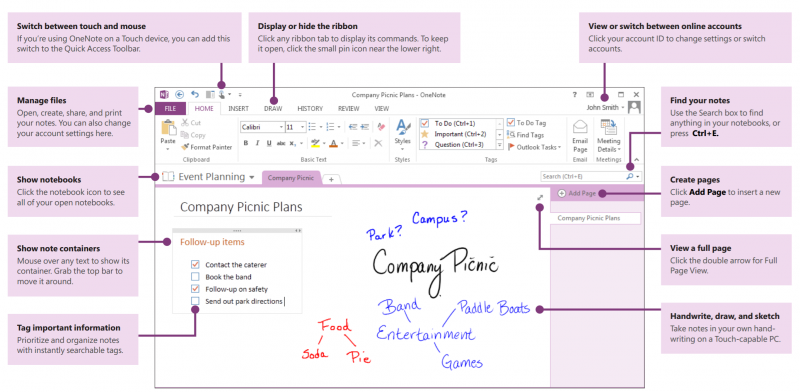

- #Examples of onenote notebooks pdf
- #Examples of onenote notebooks code
- #Examples of onenote notebooks password
#Examples of onenote notebooks pdf
Exporting Notebook to PDF Exporting Notebook to PDF with Options Export to PDF as a Flattened NotebookĪspose.Note API can be used to export a OneNote notebook as a Flattened PDF which exports all children to a single directory. and Aspose.Note for Java x.x will be displayed against these fields. Please note that you cannot set values against the Application and Producer fields, because of Aspose Ltd. This article shows all the approaches to export Notebook to PDF. The API can export the document to PDF directly or we can also specify additional save options using the NotebookPdfSaveOptions class. Exporting Notebook to Image Exporting Notebook to Image with Options Export to Image as a Flattened Notebook Converting Notebook Document to PDFĪspose.Note API provides the capability to convert Notebook documents (.onetoc2) to PDF format. This article shows all the approaches to export Notebook to the image. The API can export the document to image directly or we can also specify additional save options using the NotebookImageSaveOptions class. Converting Notebook Document to ImageĪspose.Note API provides the capability to convert Notebook documents (.onetoc2) to image. The removeChild method exposed by the API’s Notebook class lets you remove a child node that is meant to be removed from the Notebook. Remove a Child Node From OneNote NotebookĪspose.Note API provides the capability to remove a child node from OneNote notebook.

The appendChildLast method exposed by the Notebook class allows you to achieve this. Adding a Child Node to OneNote NotebookĪspose.Note API lets you add/append a child node to a OneNote Notebook. onetoc2 NotebookĪ password-protected notebook can be loaded with the help of LoadOptions class of the API specifying the password.
#Examples of onenote notebooks password
Loading Password Protected Documents as a part of. Note that “Root Notebook -> Notebook 1 Level 1 -> Section 1 Level 2” is not loaded at the same time as “Root Notebook” instead it will be loaded instantly while “Root Notebook -> Notebook 1 Level 1” is loading, as it is the first-level child for the mentioned notebook and the last is not Online itself. Then the only children will be loaded instantly are: Root Notebook -> Section 2 Level 1, Root Notebook -> Notebook 2 Level 1 and Root Notebook -> Notebook 2 Level 1 -> Section 1 Level 2. OneNote Online first-level child documents/notebooks are always loaded instantly.įor instance, if there is a hierarchy structure: In the current implementation, lazy loading implemented only for OneNote 2010 child documents/notebooks. Loading Notebook with Lazy Loading Option Loading Notebook Instantly
#Examples of onenote notebooks code
The following code snippets demonstrate both approaches. The last can be achieved by passing to the Notebook constructor NotebookLoadOptions with the InstantLoading flag set to true. An alternative approach is to load all children at once. their loading is postponed until direct access to a specific child. Loading Notebook File Loading Notebook File from Stream Loading Notebook File with LoadOptionsīy default, notebook’s child documents are loaded “lazily”, i.e. The NotebookLoadOptions class provides further options to load the file with user-specified options.

The Notebook class exposed by the API lets you read a OneNote Notebook (.onetoc2) file from disc. Saving Notebook to Stream Support of Password Protected Documents Writing as Part of. This article shows creating and saving a Notebook document. OneNote notebook can be created using the default constructor of Notebook class. The Notebook class exposed by the API lets you create a notebook from scratch and save it as OneNote Notebook (.onetoc2).


 0 kommentar(er)
0 kommentar(er)
